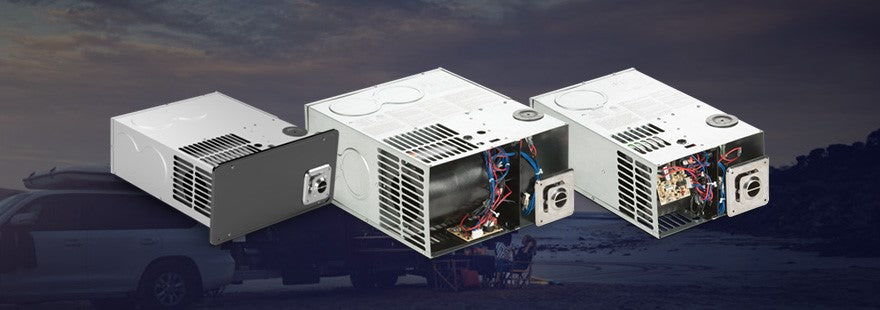A reliable furnace is a must to keep your RV nice and toasty through any fall or winter journey. However, your RV furnace is going to need to be replaced at some point, and it can be difficult to determine exactly what you need. But choosing a replacement gas heater doesn’t have to be complicated or exasperating. In fact, by following this RV furnace replacement guide, it can be incredibly easy.
Finding Your Replacement Ducted Propane Furnace
The simplest way to choose a replacement ducted propane RV furnace is to find a model made specifically as a replacement for your current model. Follow the easy-to-use chart below to quickly identify which Atwood RV furnace replacement model corresponds to your current RV furnace.
| Original Model | Replacment Model |
|---|---|
| Atwood 36542 | Atwood 32723 |
| Atwood 36543 | Atwood 32723 |
| Atwood 36545 | Atwood 32719 AFSD16111 |
| Atwood 36548 | Atwood 32715 AFSD12111 |
| Atwood 36566 | Atwood 32719 AFSD16111 |
| Atwood 36913 | Atwood 32653 |
| Atwood 36915 | Atwood 32650 |
| Atwood 36917 | Atwood 32659 |
| Atwood 36919 | Atwood 32656 |
| Atwood 37635 | Atwood 32675 or Atwood 32690 |
| Atwood 37636 | Atwood 32684 AFMD30111 |
| Atwood 37963 | Atwood 32663 |
Make sure to check the dimensions of the replacement models, as some are sized a bit differently from their predecessors. While the fit is very close, newer replacement models have slightly deeper dimensions than older models. If the cutout doesn’t fit, a trim ring or bottom discharge kit can be purchased to help the RV furnace fit correctly.
Keep in mind that any furnace that was made to replace another will have the same British Thermal Units (BTUs)* and similar amp draw and ignition. It will also use the same type of fuel as the older model.
For those who have never had a propane RV furnace before, had a model other than one listed above, or are simply not aware of their previous model number, continue reading to find the perfect furnace for your RV.
*BTU is the amount of heat required to raise the temperature of 15.34 fluid ounces of water by one degree Fahrenheit.
1. How Much Space Do You Have for Your RV Furnace?
If you weren’t able to find an exact replacement furnace for your RV, don’t worry. There are other methods of finding your perfect RV furnace.
The first step is to measure to see what size of RV furnace will fit in your existing cutout. If you’re looking for a standard suburban RV furnace, your measurements need to be precise. You can then use the chart below to find which Atwood RV furnace model corresponds to your current cutout measurements.
| RV Furnace Size | Atwood RV Furnace Model |
|---|---|
| 12” W x 7” H x 20” D | Atwood 32715 AFSD12111 |
| Atwood 32719 AFSD16111 | |
| Atwood 32723 | |
| 16.5” W x 7” H x 20” D | Atwood 32663 |
| Atwood 32675 | |
| Atwood 32684 AFMD30111 | |
| Atwood 32690 | |
| 16.5” W x 9” H x 20” D` | Atwood 32650 |
| Atwood 32656 | |
| Atwood 32653 | |
| Atwood 32659 |
2. How Large of an Area Are You Heating?
When you’re looking into purchasing a new RV furnace, you need to consider the size of the space you’d like to heat. Do you want a unit that will heat the entire RV or are you looking for more localized heat?
To determine the BTU input required for your RV, check the data plate on your current furnace. Your replacement RV furnace should be the same BTU size or a close equivalent. The larger the RV furnace, the greater the heat output and coverage area will be. Make sure to not oversize your furnace – too much heating capacity can cause rapid cycling and reduced comfort levels.
Also, keep in mind that different climates also impact your heating needs. Warmer climates require about 25 to 35 BTUs per square foot. In colder climates, as much as 45 to 60 BTUs will be needed.
3. How Would You Like to Power Your RV Furnace?
There are two options when it comes to powering your RV furnace: alternating current (AC) or direct current (DC).
An AC system is similar to one that you’d find in a typical home. Bigger appliances like microwaves, air conditioning units and power outlets tend to run off an AC system. A DC system runs off one or more battery systems installed in your RV. Typically, lights, fans, water pumps and electronics run off DC power.
Both systems are connected and work together. If you have AC power coming into your RV, it will charge up your DC system via a converter device. Most RVs also have an inverter device, which turns DC power into AC power. While most people prefer to use a DC-powered furnace, Boat & RV Accessories does offer options for those needing or wanting an AC power alternative.
And if you’re looking for an energy efficient furnace, you can rest easy. Atwood’s newest RV furnace models offer the same energy efficiency as their predecessors, which were designed to maximize air distribution while keeping the amp draw low.
Purchasing a new RV furnace doesn’t have to be confusing if you go into it knowing what you need and what you want.


